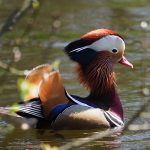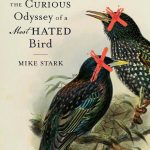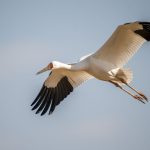Broad-winged Hawks are one of the most abundant northbound migrants at Swainson’s Hawk Bird Observatory, often with over 100,000 (and sometimes many more) being counted on their way north every spring.
One cannot rule as The Greatest Birder In The World on his own. Sure, if you were to kidnap me, blindfold and drug me, push me out of a plane with a parachute over somewhere in, say, Malaysia, I would be able to figure out my exact latitude and longitude within minutes simply by recognizing the subtle local variation in call notes by Crimson Sunbirds and Ashy Minivets. Of course, I’m not busy with that sort of thing every day…most of my day to day duties revolve around telling shadowy organizations like the AOU and ABA what to do. Sure, the AOU has the final say in whats a species, whats not, yadda yadda yadda….but who tells them what to say? Yup….everyone needs someone to whisper in their ear…George W. Bush had Dick Cheney, the birding community has Felonious Jive.
But I digress. I’ve been sciencing really hard lately. After all, there are some epic splits coming your way….what do you think about new species of storm-petrel and murrelet that can be found in the United States? Hmmmm?
Perhaps you have heard of my esteemed colleague, one Seagull Steve. He is a fantastic birder, absolutely brilliant…according to the universally accepted Global Birding Ranking Scale, he is the Number 7 birder in the entire nation. He even writes a crappy blog about….birds. How original.
Despite the grief that I give that man (he deserves it), he has proved to be a great ally, and today he has assisted in filling in some gaps in our knowledge. My recent work with birds has prevented me from, ironically, working on seeing birds lately. I know Seagull Steve, who is slaving away on Snowy Plover and Least Tern monitoring in San Diego, is busy as well, but he can’t help but reflect on how different his current job is from his last spring gig.
In the spring of 2011 he lived in Chavarrillo, Mexico, which lies between the cities of Veracruz and Xalapa on the east side of the country. This part of the world is well-known for the fall river of raptors, which tallies millions of migrants every season. But Seagull was counting birds that moved north in spring, as well as anything else he could lay eyes on. As the lead hawk counter for Swainson’s Hawk Bird Observatory, he had the pleasure of helping count hundreds of thousands of raptors (not too shabby for spring, eh?) and getting a really good tan at the same time. The local forest birds were a constant source of facemelt as well…when Blue Mockingbird, Keel-billed Toucan, Crimson-collared Grosbeak and Red-legged Honeycreeper reside within walking distance, you can temporarily forget the horror and debilitating pain that is Montezuma’s Revenge.
Here are a few photographic notes from his stint.
It’s amazing to see flocks of thousands of raptors together, and it seems counter intuitive to those who have not already put in time at places like Hawk Mountain or Cape May….this a mixed flock of Swainson’s and Broad-wings.
Common Black-Hawks strike a unique profile compared to most other raptor species. This is really the bird that should be called “Broad-winged Hawk”.
One of the tasks one must learn as a raptor counter is trying to figure out who is passing through and who lives in the area. It’s not an exact science, but after a few weeks you get the idea of who is just hanging out on the local thermals and who is actually going north. Roadside Hawks are generally considered resident birds at the Chavarrillo site.
Staring at the sky for hours on end can reward you with more than just raptors and insanity. Anhingas, American White Pelicans, Wood Storks, and White-collared and Lesser Swallow-tailed Swifts (like this one) could occasionally be seen flying over.
Brown Jays are abundant throughout eastern Mexico, perhaps even more so than their facemelting Green Jay cousins. I am surprised they do not have a stronger foothold on the Lower Rio Grande Valley in Texas, since they appeared to have no habitat requirements besides trees.
Besides what was flying overhead, the handful of trees surrounding the hawkcounting tower often would have interesting birds. Yellow-winged Tanagers were my frequent eye-level companions.
Eastern Mexico is blessed/cursed with a trio of similar-looking species: Social Flycatcher, Great Kiskadee and Boat-billed Flycatcher. Boat-billeds can be identified by their massive, barge-shaped bills and lack of rufous tones on the wings. They are a fairly common bird in the surrounding forests of Chavarrillo, and insects everywhere fear a fate that lies between those enormous mandibles.
When mid-April rolls around, Mississippi Kites swarm through the area in jaw-dropping numbers, and unlike the other migrant raptors, tend to move in a single mass….when one bird flies northeast, the entire flock does, instead of breaking off piecemeal one at a time. Blessed is the birder who is lucky enough to observe these aerial bivouacs.
Early in the morning raptors will fly in low over town after roosting on the neighboring mountain for the night. As soon as the local thermals get going, birds tend to stay pretty high up. I always appreciated when the Mississippi Kites stooped to the level of us lowly humans.
Swainson’s Hawk Bird Observatory is accessible to the public, and is in operation when the bulk of birds go over in March and April. The mountains and canyon to the south and east of town likely make for great birding any time of year. Intrepid birders visiting Veracruz state would do well to put some time in here.





















Leave a Comment